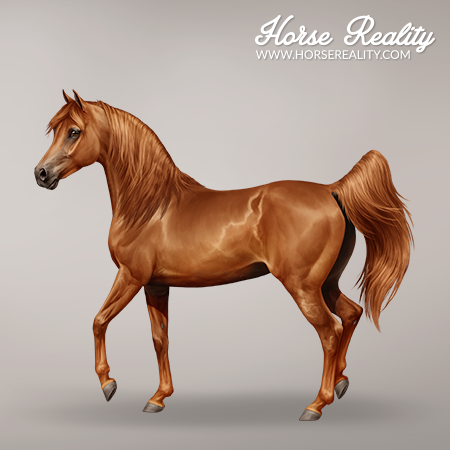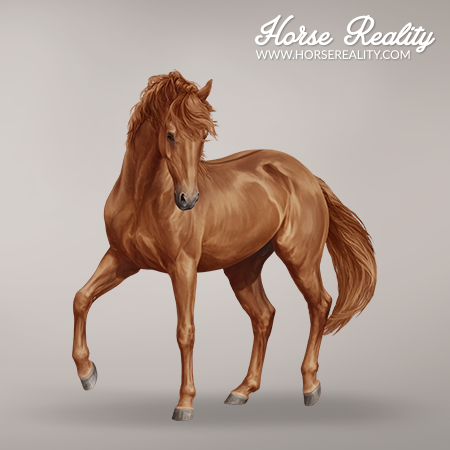Chestnut is one of the three base colours horses can have, next to black and bay. Chestnuts are also often called red or sorrel. Chestnut-based horses can also be affected by modifiers and/or dilutions, resulting in various other different colours.
¶ Phenotype
Chestnut is characterised by an entirely red coat with red points (mane, tail, ear tips, lower legs). The shade of red can vary widely between horses. It can range from a yellowish shade to a reddish brown, to being so dark they almost appear black. In Horse Reality, the shade of chestnut a horse gets once they turn into an adult is determined by chance (outside of the effect of modifiers).
| Chestnut Base - Arabian Horse |

|
¶ Genotype
Chestnut horses are always homozygous recessive for extension (e/e), meaning they can't produce black pigment and therefore only have red hair. This can be tested at the Laboratory. The agouti gene, therefore, does not influence chestnuts as it acts on black pigment only. Modifiers or dilutions that act on black pigment only such as silver will also not affect their coat colour. This means the following genotypes will lead to chestnut phenotypes:
- e/e + A/A
- e/e + A/a
- e/e + a/a
Since chestnut is caused by recessive alleles, breeding two chestnut-based horses will always result in a chestnut-based foal. Two black or bay-based horses, however, could produce a chestnut foal if both are carrying an e-allele. This can lead to some surprises when a chestnut foal with a pedigree full of black or bay-based horses suddenly pops up!
In real life, an alternate recessive e-allele called ea is present in a select number of breeds. This allele works the same way as the e-allele and is therefore not implemented separately in the game.
¶ Modifiers and dilutions
The following modifiers and/or dilutions can act on the chestnut base coat:
¶
Modifiers
Different modifiers can alter the phenotype of chestnut-based horses.
¶ Flaxen
The modifier flaxen (f) will turn the mane and tail of chestnut horses into a yellow or even nearly pure white colour. The lower legs, especially when they are feathered to some degree, can also be altered to a lighter colour, though this is not always as profound as the mane and tail.
Foals may be born with a flaxen mane and tail, or with a normal red mane and tail which will lighten as they age.
The genetics behind flaxen haven't been discovered yet; therefore, it also can't be tested in Horse Reality. In-game, the allele that causes flaxen is recessive.
¶ Sooty
Sooty (STY) is a modifier that causes a darkening of the coat. Surprisingly, foals are born a lighter shade of chestnut and darken as they age.
Sooty can affect the chestnut-based coat in different ways: it can uniformly darken it, be concentrated on the bottom half of the horse (often seen on sooty palominos) or cause pronounced dappling on the coat. Chestnut horses that have a considerably darker shade are often called liver chestnuts. They range from dark red to chocolate and sometimes nearly black, which can make it hard to visually distinguish them from true black horses.
Sooty is not testable and its dominance can differ between breeds and coat colours.
¶ Pangaré
Pangaré (PA), also sometimes referred to as mealy, is a modifier that only affects red pigment. It mainly lightens the areas above the muzzle, eyes, and the underside of the body (flanks, belly).
Since the genetics behind pangaré are still unknown, it is not possible to test for the allele responsible for pangaré in-game. In Horse Reality, the allele causing the pangaré phenotype is dominant.
| Chestnut Base + Modifiers - Brumby Horse | ||

Chestnut + f/f |

Chestnut + sooty |

Chestnut + PA/pa or PA/PA |
¶ Dilutions
Chestnut-based coats can be lightened when other dilution alleles are present, sometimes drastically altering the appearance of the coat.
¶ Cream and Pearl
The cream and pearl alleles are located on the same gene. Cream is an incomplete dominant allele. Heterozygous cream (CR/n) dilutes the coat of chestnut horses to a golden colour, and the mane and tail to nearly white. This is called palomino. Homozygous cream (CR/CR) dilutes chestnut horses to a pale creamy colour called cremello.
Pearl is a recessive allele that also interacts with cream. Homozygous pearl (prl/prl) dilutes chestnut horses to a uniformly golden colour with mottled skin. CR/prl creates a lighter colour, more similar to homozygous cream.
| Chestnut + Cream and Pearl - Pura Raza Española and Irish Cob Horse | |

Chestnut + CR/n |

Chestnut + CR/CR |

Chestnut + prl/prl |

Chestnut + CR/prl |
¶
Dun
The dominant dun allele (D) both dilutes and creates primitive markings (dorsal, leg stripes, etc.) on the coat. Non-dun 1 (nd1) is a mutation on the same gene that causes primitive markings, without the dilution effect. When heterozygous cream (CR/n) and dun are both present, the colour is often called dunalino.
| Chestnut + Dun - Irish Cob Horse and Namib Desert Horse | |

Chestnut + D/D, D/nd1, or D/nd2 |

Chestnut + nd1/nd1 or nd1/nd2 |
¶ Champagne
Champagne (CH) is a dominant allele that dilutes chestnut horses to a colour similar to palomino; a golden body with a lighter mane and tail. The skin is mottled, and the eyes have an amber-like colour. Chestnut horses with champagne are called gold champagne. When heterozygous cream (CR/n) is present, the colour is called gold cream.
| Chestnut + Champagne - Quarter Horse | |

Chestnut + CH/CH or CH/n |

Chestnut + CR/n + CH/CH or CH/n |
¶ Breeds
Chestnuts can be found in most horse breeds. In most of them, chestnut is fairly common, but in others, the colour can sometimes stay hidden for a long time: It is recessive, and humans have selected other colours within certain breeds for a long time. A good example of this is the Friesian Horses - while the large majority of Friesian Horses are black, on rare occasions, a chestnut foal is born. The following table lists all breeds that can currently have the recessive extension (e) allele in-game.
| Breeds |
| Akhal-Teke Horse |
| Arabian Horse |
| Brabant Horse |
| Brumby Horse |
| Camargue Horse |
| Cleveland Bay |
| Exmoor Horse |
| Finnhorse |
| Fjord Horse |
| Friesian Horse |
| Haflinger Horse |
| Icelandic Horse |
| Irish Cob Horse |
| Kladruber Horse |
| Knabstrupper |
| Lipizzaner Horse |
| Lusitano |
| Mongolian Horse |
| Mustang Horse |
| Namib Desert Horse |
| Noriker Horse |
| Norman Cob |
| Oldenburg Horse |
| Pantaneiro Horse |
| Pura Raza Española |
| Quarter Horse |
| Shetland Pony |
| Shire Horse |
| Suffolk Punch |
| Thoroughbred |
| Trakehner Horse |
| Welsh Pony |
¶ References
- Bellone R., Sponenberg D. P., Equine Color Genetics, 4th Edition, 2017, Wiley-Blackwell
- Bowling A, Ruvinsky A., 2000, The Genetics of the Horse, 2000
- UC Davis Veterinary Genetics Laboratory; https://vgl.ucdavis.edu/test/red-factor-horse and https://vgl.ucdavis.edu/test/agouti-horse; Access: November 2022
- Generatio Center for Animal Genetics; https://generatio.de/en/knowledge/basic-genetics/coat-colours-horse, https://generatio.de/en/guidance/lexicon/extension-chestnut-base-colour-e-locus-horse and https://generatio.de/en/guidance/lexicon/agouti-bayblack-base-colour-locus-horse; Access: November 2022